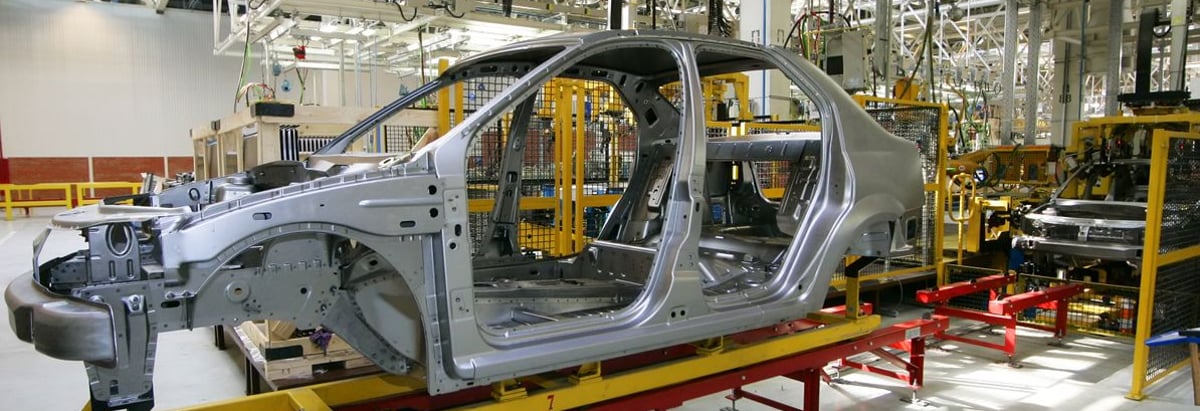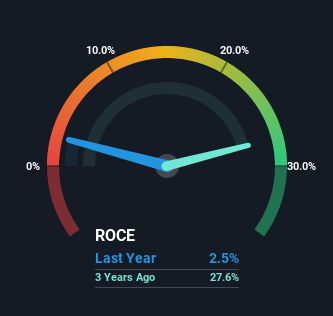Returns On Capital At Geely Automobile Holdings (HKG:175) Paint A Concerning Picture

There are a few key trends to look for if we want to identify the next multi-bagger. In a perfect world, we'd like to see a company investing more capital into its business and ideally the returns earned from that capital are also increasing. Put simply, these types of businesses are compounding machines, meaning they are continually reinvesting their earnings at ever-higher rates of return. Although, when we looked at Geely Automobile Holdings (HKG:175), it didn't seem to tick all of these boxes.
Return On Capital Employed (ROCE): What is it?
If you haven't worked with ROCE before, it measures the 'return' (pre-tax profit) a company generates from capital employed in its business. The formula for this calculation on Geely Automobile Holdings is:
Return on Capital Employed = Earnings Before Interest and Tax (EBIT) ÷ (Total Assets - Current Liabilities)
0.025 = CN¥1.8b ÷ (CN¥134b - CN¥60b) (Based on the trailing twelve months to December 2021).
Thus, Geely Automobile Holdings has an ROCE of 2.5%. In absolute terms, that's a low return but it's around the Auto industry average of 2.7%.
Check out our latest analysis for Geely Automobile Holdings

Above you can see how the current ROCE for Geely Automobile Holdings compares to its prior returns on capital, but there's only so much you can tell from the past. If you'd like, you can check out the forecasts from the analysts covering Geely Automobile Holdings here for free.
How Are Returns Trending?
In terms of Geely Automobile Holdings' historical ROCE movements, the trend isn't fantastic. Over the last five years, returns on capital have decreased to 2.5% from 18% five years ago. Although, given both revenue and the amount of assets employed in the business have increased, it could suggest the company is investing in growth, and the extra capital has led to a short-term reduction in ROCE. And if the increased capital generates additional returns, the business, and thus shareholders, will benefit in the long run.
On a related note, Geely Automobile Holdings has decreased its current liabilities to 45% of total assets. So we could link some of this to the decrease in ROCE. What's more, this can reduce some aspects of risk to the business because now the company's suppliers or short-term creditors are funding less of its operations. Some would claim this reduces the business' efficiency at generating ROCE since it is now funding more of the operations with its own money. Keep in mind 45% is still pretty high, so those risks are still somewhat prevalent.
The Bottom Line On Geely Automobile Holdings' ROCE
While returns have fallen for Geely Automobile Holdings in recent times, we're encouraged to see that sales are growing and that the business is reinvesting in its operations. In light of this, the stock has only gained 7.8% over the last five years. So this stock may still be an appealing investment opportunity, if other fundamentals prove to be sound.
On a separate note, we've found 2 warning signs for Geely Automobile Holdings you'll probably want to know about.
If you want to search for solid companies with great earnings, check out this free list of companies with good balance sheets and impressive returns on equity.
New: Manage All Your Stock Portfolios in One Place
We've created the ultimate portfolio companion for stock investors, and it's free.
• Connect an unlimited number of Portfolios and see your total in one currency
• Be alerted to new Warning Signs or Risks via email or mobile
• Track the Fair Value of your stocks
Have feedback on this article? Concerned about the content? Get in touch with us directly. Alternatively, email editorial-team (at) simplywallst.com.
This article by Simply Wall St is general in nature. We provide commentary based on historical data and analyst forecasts only using an unbiased methodology and our articles are not intended to be financial advice. It does not constitute a recommendation to buy or sell any stock, and does not take account of your objectives, or your financial situation. We aim to bring you long-term focused analysis driven by fundamental data. Note that our analysis may not factor in the latest price-sensitive company announcements or qualitative material. Simply Wall St has no position in any stocks mentioned.
About SEHK:175
Geely Automobile Holdings
An investment holding company, operates as an automobile manufacturer primarily in the People’s Republic of China.
Flawless balance sheet and good value.


